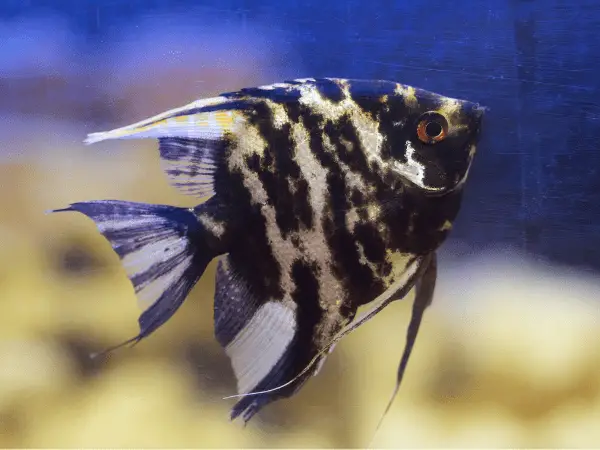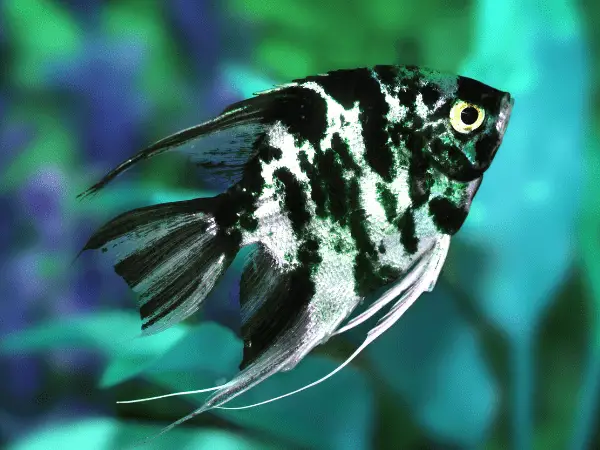Black Lace Angelfish require meticulous care and a well-maintained aquarium to thrive, and breeding them demands specific water conditions. They are a striking ornamental species popular among aquarists for their elegance and distinct appearance.
The Black Lace Angelfish, known for its dramatic dark fins and scales resembling delicate lacework, is a captivating addition to any freshwater tank. Native to South America, these angelfish belong to the genus Pterophyllum and thrive in a close replica of their natural Amazonian habitat.
Aquarists prize them for not only their beauty but also for their relatively peaceful temperament, making them suitable for community tanks. They require spacious environments, as adults can grow up to 6 inches. These fish prefer soft, slightly acidic water, and a varied diet to maintain their health.
Characteristics Of Black Lace Angelfish
The Black Lace Angelfish dazzles fish enthusiasts with its stunning beauty. This freshwater species stands out in any aquarium. Below you will find detailed insights into their unique characteristics.
Physical Appearance
The Black Lace Angelfish boasts an arresting display. It derives its name from its coloration and finnage. Key features include:
- Deep black hue with delicate silver or grey patterns.
- Fins resemble elegant lace, long and flowing.
- Body is laterally compressed, typical of angelfish.
- Large round eyes are prominent on their faces.
| Size (Adult) | Lifespan | Tank Level |
|---|---|---|
| Up to 6 inches | 10+ years | Mid-dweller |
Their majestic fins can span up to 8 inches across in mature specimens.
Temperament
Black Lace Angelfish are as serene as they are beautiful. They usually show:
- Peaceful behavior towards most tank mates.
- They may become territorial during breeding.
- Social with their kind; prefer to live in groups.
- Mild-mannered with non-aggressive community fish.
Providing a spacious tank with plenty of hiding spots encourages their tranquil nature. Suitable companions include tetras and corydoras.

Habitat And Tank Requirements
Creating the perfect underwater paradise for Black Lace Angelfish demands attention to their natural habitat and tank requirements. These elegant creatures thrive in environments that emulate the warm rivers of the Amazon Basin. A carefully crafted setup is essential for their health and happiness. Let’s dive into the specifics of the ideal tank conditions for these majestic fish.
Tank Size
Black Lace Angelfish need ample space to gracefully swim and turn. A minimum tank size of 30 gallons is recommended for a pair. The golden rule is: the larger the tank, the better. This species grows quite large, and providing them enough room is critical for their wellbeing.
Water Conditions
Mimicking the Amazon’s water conditions is key. Aim for a pH between 6.8 and 7.8, and water temperature ranging from 76°F to 84°F (24°C to 29°C). It’s crucial to maintain low nitrate levels and moderate water movement to keep your Angelfish healthy. Regular water changes are mandatory.
- pH Level: 6.8 – 7.8
- Temperature: 76°F – 84°F (24°C – 29°C)
- Nitrate Levels: Keep low
Decorations And Plants
Black Lace Angelfish take pleasure in a territory that provides plenty of hiding spaces. Use driftwood, rocks, and caves to create shelters. Live plants are not just decorative but vital for their environment. Plants like Amazon Sword and Anubias offer excellent foliage and mimic their natural habitat. Ensure that the decorations do not have sharp edges to prevent injury.
- Driftwood for natural feel
- Rocks and Caves for hiding
- Live Plants like Amazon Sword and Anubias
Feeding Black Lace Angelfish
Proper nutrition is key to maintaining the health and vibrant colors of your Black Lace Angelfish. Understanding what they eat, how much, and how often can spell the difference between a thriving aquarium and fish health issues. Let’s dive into the details of feeding these elegant creatures.
Dietary Requirements
- Black Lace Angelfish are omnivores, requiring both plant and animal-based foods.
- A variety of foods prevents nutritional deficiencies.
- Include quality flake food, frozen and live options like brine shrimp.
- Vegetables such as blanched spinach add to a balanced diet.
- Supplement with high-quality pellets designed for angelfish.
Feeding Schedule
Black Lace Angelfish thrive on a consistent feeding schedule. Here’s a simple plan to keep them happy and healthy:
| Age | Frequency | Amount |
|---|---|---|
| Juveniles | 3-4 times a day | Small portions |
| Adults | Twice a day | Enough to consume in 3 minutes |
Stick to this schedule and adjust based on your angelfish’s growth and behavior. A well-fed angelfish is a sign of a loving and attentive owner.

Caring For Black Lace Angelfish
Black Lace Angelfish are a stunning variety of freshwater angelfish. Known for their unique dark coloration, they bring a touch of elegance to any aquarium. Proper care ensures they live healthy, vibrant lives. Dive into the essentials of maintaining, ensuring optimal water quality, and managing compatibility with other fish in your tank.
Tank Maintenance
Keeping an immaculate home for your Black Lace Angelfish is essential. They thrive in well-maintained environments. Here’s what to focus on:
- Regular Cleaning: Wipe down tank walls; vacuum gravel to remove debris.
- Filter Check: Inspect and clean filters often to keep water pristine.
- Plant Care: Trim live plants; this ensures a tidy habitat.
Water Quality
Angelfish demand specific water conditions:
| Parameter | Ideal Range |
|---|---|
| pH Level | 6.5 – 7.5 |
| Temperature | 76°F – 82°F |
| Hardness | 3-8 dKH |
Test water weekly. Adjust using conditioners and heaters as needed.
Compatibility With Other Fish
Not all tank mates are suitable:
- Choose Peaceful Fish: Opt for species that share a similar demeanor.
- Avoid Fin-nippers: Small, aggressive fish can stress angelfish.
- Monitor Interactions: Keep an eye on fish behavior to prevent bullying.
Successful cohabitation means a harmonious tank where all fish can flourish.
3 Best Tank Mates For Black Lace Angelfish
| Tank Mates | Description |
|---|---|
| Cardinal Tetras | Peaceful, schooling fish that complement Angelfish |
| Corydoras Catfish | Bottom-dwelling, compatible with Angelfish |
| Betta Fish | Colorful, compatible if tank size and setup allows |
Breeding Black Lace Angelfish
Breeding Black Lace Angelfish is an exciting journey for aquarists. These creatures bring an elegant touch to any tank. With proper care, you can see new life blossom in your aquarium. Begin with creating the right environment for mating. Then, move on to egg and fry care. Let’s dive into the essentials of spawning these aquatic beauties.
Breeding Setup
To start breeding, your Black Lace Angelfish will need a peaceful home. Use a separate tank, away from busy community tanks. Choose a tank that holds at least 20 gallons of water. The water should be slightly acidic to neutral. Ensure a temperature between 78-84°F (25.5-28.9°C). Clean, well-oxygenated water is vital. Provide broad leaves or a slate for angelfish to lay their eggs on.
Egg Care
Once the angelfish eggs are laid, they need attention. Angelfish parents often guard their eggs. Yet, in tanks, it’s safer to separate them. Use a gentle sponge filter to maintain water quality without harming the eggs. Watch out for unfertilized eggs; they turn white and may develop fungus. Remove these eggs to keep others safe. A daily check is important.
Egg development takes about 7 days.
Raising Fry
When the fry hatch, they will feed off their yolk sacs for the first few days. After this, they require very fine food. Options include:
- Brine shrimp nauplii
- Finely crushed flake food
- Commercial liquid fry food
Feed fry multiple times a day. Keep the water clean but make changes slowly. Watch out for signs of disease or stress. As the fry grow, they can eat larger food. By twelve weeks, they show their classic black lace pattern. At this age, they can join a community tank. Gradual introduction to the new environment is key.

Common Diseases And Health Issues
Like all aquarium fish, Black Lace Angelfish face health challenges and diseases. Recognizing and treating these issues early is vital for their well-being. This section discusses common health problems and solutions.
Prevention
Preventing disease is always better than treating it. Black Lace Angelfish thrive in well-maintained tanks. Maintaining a clean environment is key. Here’s how to prevent illness:
- Regular water changes: Replace 20-25% of the tank’s water weekly.
- Proper filtration: Keep the water clean and free from toxic ammonia and nitrites.
- Quarantine new fish: Avoid introducing diseases by quarantining new arrivals for two weeks.
- Feed a balanced diet: Ensure your angelfish get all the nutrients they need.
- Monitor water parameters: Check pH, temperature, and hardness regularly.
Treatment
Even with prevention, Black Lace Angelfish may fall ill. Common diseases include ich, fin rot, and bacterial infections. Treatment involves:
| Disease | Symptoms | Treatment |
|---|---|---|
| Ich (White Spot Disease) | White spots on body, scratching against objects | Raise temperature, medicated baths |
| Fin Rot | Frayed or disintegrating fins | Improve water quality, antibiotic treatment |
| Bacterial Infections | Red streaks, open sores | Isolate fish, administer antibiotics |
Always identify the exact disease before starting treatment. Consult an aquarist or vet for severe cases. Follow instructions carefully when using medications to avoid harming your fish or disrupting tank balance.
Frequently Asked Questions Of Black Lace Angelfish
What Is A Black Lace Angelfish?
A Black Lace Angelfish is a selectively bred variant of the freshwater angelfish Pterophyllum scalare. It is known for its dark, lacy black patterns on its body and fins. Ideal for aquarists who appreciate ornamental fish, it adds a dramatic flair to home aquariums.
How To Care For Black Lace Angelfish?
Caring for Black Lace Angelfish involves maintaining clean, warm water between 76-86°F and a pH of 6. 8-7. 8. They thrive on a varied diet of flakes, pellets, and live foods. Regular water changes and tank monitoring are crucial for their wellbeing.
What Tank Size Is Needed For Black Lace Angelfish?
Black Lace Angelfish require a spacious tank, ideally starting at 30 gallons for a pair. They need room to swim and grow, so larger tanks are better, especially when keeping multiple angelfish or planning for breeding.
Can Black Lace Angelfish Be Bred In Captivity?
Yes, breeding Black Lace Angelfish in captivity is possible and common. They are egg-layers and display parental care. A separate breeding tank with optimal water conditions increases success rates. Observing their pair-forming and spawning behavior is fascinating.
Conclusion
Caring for Black Lace Angelfish can be a gratifying experience for any aquarist. From the tranquil beauty they add to a tank to the fascinating process of breeding them, these graceful creatures are a testament to aquatic elegance. By ensuring proper tank conditions, diet, and water quality, your angelfish can thrive.
Remember, consistent care is key to nurturing a healthy, vibrant habitat for your finned friends. Embrace the challenge and enjoy the serene presence of Black Lace Angelfish in your aquarium.
Read also: Vitalis Fish Food Review




